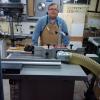A while back in 2009, the Consumer Product Safety Commission did a study about tablesaw accidents that I thought had some interesting facts in it. Before I go any further, though, let me be clear I am not a safety nazi, you are certainly free to use your tools any way you want. These are just statistics, and only describe what happens in large numbers of incidents - they say nothing about any future single accident. Nevertheless, I just thought this was some good food for thought.
They had data available from hospital emergency rooms over 2007 and 2008. Over that period, the total number of table/bench powersaw accidents that were treated in emergency rooms was estimated to be 79,500. (The reason it is an estimate is because many accidents were just reported as "powersaw" accidents, so they the took the tablesaw/bench saw ratio and multiplied that by the number of unspecified ones and added that to the ones reported to get a total for tablesaws/bench saws.) Note these numbers do not include circular saws, bandsaws, radial arm saws, and mitre saws.
The average age of those treated was 55.4 years, (the range was 11 to 94) and 97.4 percent were male - not too surprising.
Of those accidents that reported the type of saw, 68.7 percent involved cabinet saws, 18.3 percent contractor saws, and 10.5 percent bench saws.
78.8 percent of the saws did not have a safety switch, 75.0 percent of the saws had the blade guard removed, 20.4 per cent had a riving knife in use, and 24.4 per cent had a kickback pawl in use. In 85.7 percent of the cases, the saw was doing a rip cut.
In 40.5 percent of the accidents the stock jumped or kickbacked. When stock kickback caused the injury, the operator’s hand was pulled into the saw in 65.2 percent of those cases.
The motor was running in 94.5 percent of the cases (!) and a pushstick was used in 35.6 percent.
Anyway, just thought those were some interesting numbers. You can look at the report yourself by clicking here.




 Reply With Quote
Reply With Quote





